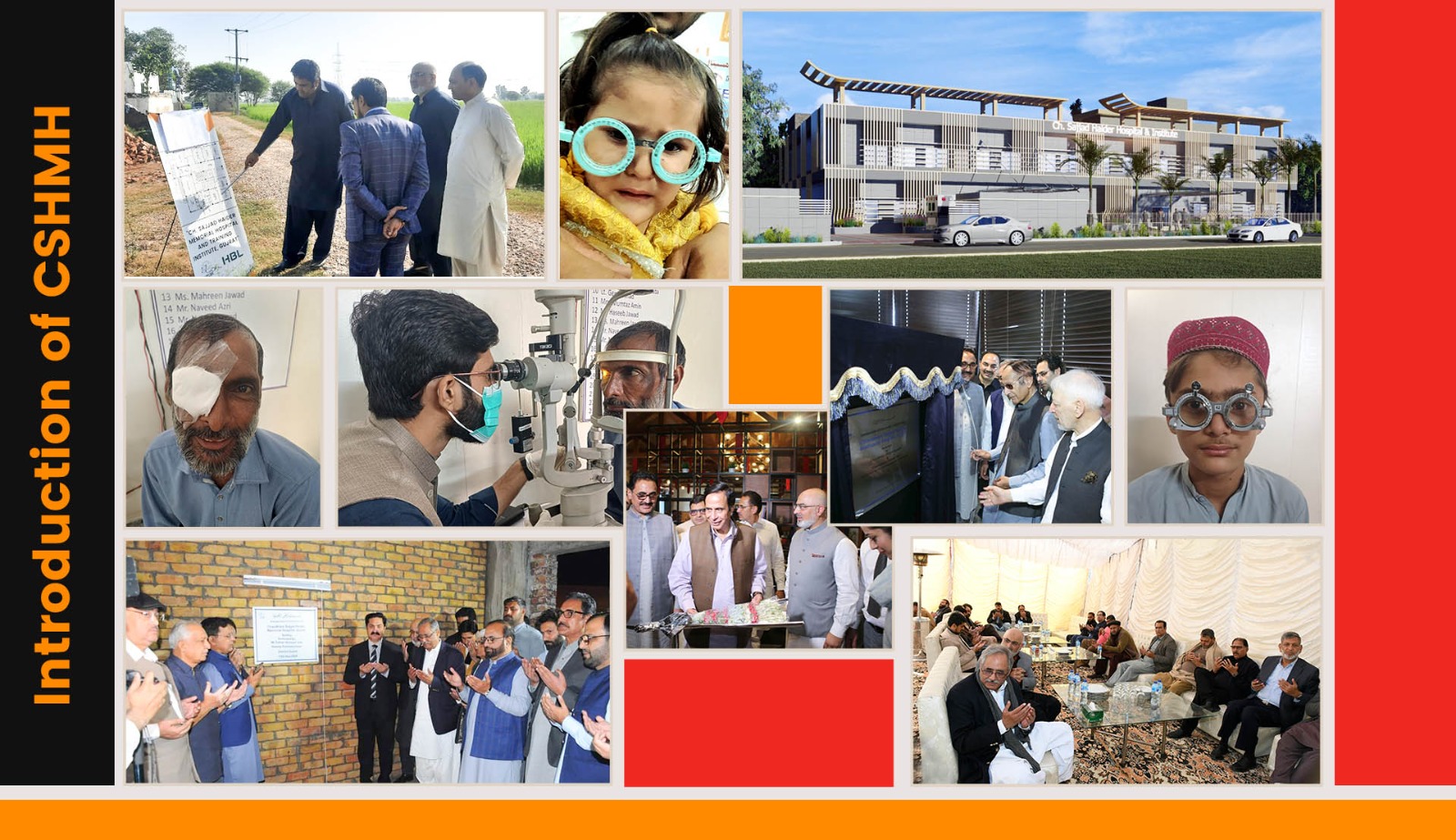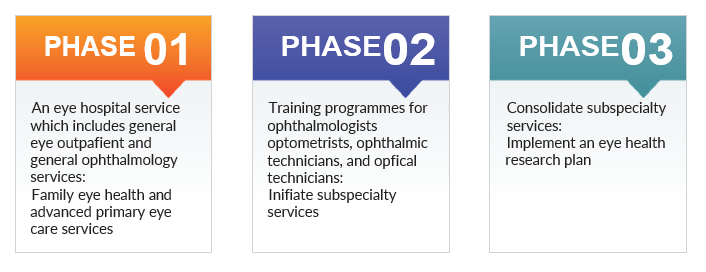- Establish a state of the art terfiary eye care hospital that will enhance access and affordability for low and medium income groups and thereby contribute towards universal eye health coverage.
- Adopt the principles of Integrated People Centred Eye Care to establish family eye health and advanced primary eye care services in collaborafion with public sector primary health care services.
- Develop an accredited human resource development programme to train a corps of eye health professionals and contribute to the human resource needs for eye care in Punjab and Pakistan.
- Implement an eye health research plan to generate evidence for policy advocacy for eye care.
INTRODUCTION

Gujrat District
Gujrat district lies in the northern part of Punjab province. It lies adjacent to Jhelum district in the northwest, Gujranwala and Sialkot in the east and southeast, and Mandi Bahauddin in the west. The River Jhelum separates it from Jhelum district and River Chenab from Gujranwala and Sialkot. It has a populafion of over 2.8 million people.
Donation
A local philanthropist has graciously donated 8 kanals of prime land of Gujrat District to CHEF Internafional to establish a charitable hospital and insfitufion, known as "Chaudhry Sajjad Haider Memorial Hospital and Training Center" in District Gujrat. The project will be implemented in 3 phases. The hospital is located in the village of Dheerkey. The Hospital is surrounded by villages Dheerkey, Shadiwal, Mohla, Samma, Ghazichak, Kathala, Dheerky Khurd etc. which are within a distance of one kilometer from the Hospital, The populafion of these villages are over 20,000 and together with other smaller villages the hospital will cater to a rural populafion of over 30,000 in its surroundings, in addifion to the urban populafion nearby which is within a radius of hve kilometers of the hospital.
Chaudhry Sajjad Haider Memorial Hospital and Institute (CSHMH&I): Visionary Healthcare Initiative
The Chaudhry Sajjad Haider Memorial Hospital and Institute (CSHMH&I) is a philanthropic healthcare project initiated by the family of the late Chaudhry Sajjad Haider, in collaboration with CHEF International. Located in Gujrat, Pakistan, this initiative aims to enhance the health and well-being of the local community through corporate social responsibility efforts.
In partnership with CHEF International a non-profit organization with over 12 years of experience in health education and eye care. CSHMH&I is developing a state-of-the-art eye hospital in the Gujrat district. This facility is designed to provide high-quality eye care services and serve as an accredited institute for training eye health professionals in ophthalmology and vision sciences.
The foundation stone for the hospital was laid on July 7, 2019, by former Prime Minister Chaudhry Shujaat Hussain and Speaker of the Punjab Assembly Chaudhry Pervaiz Elahi. CSHH
The hospital is located at Village Dheerkay Kalan, UC Samma, Bypass Road, Gujrat. For more information, you can contact them at +92 300 859 1571. CSHH
This initiative reflects the family's commitment to improving healthcare access and quality for the people of Gujrat, aligning with their vision of social responsibility and community development.
Vision for Life: Why Eye Health Deserves the Spotlight
Among the many health priorities, eye health stands out as a critical yet often underestimated aspect of overall well-being. The ability to see shapes how individuals engage with the world, impacting their quality of life from infancy to old age.
In young children, untreated vision problems such as refractive errors or cataracts can lead to amblyopia, commonly known as lazy eye, resulting in lifelong visual impairment. This not only affects their ability to socialize but also hampers their education and limits future career opportunities, ultimately reducing their potential to contribute productively to society.
For adults, good vision is essential for sustaining employment and generating income. Studies consistently link blindness and vision impairment with poverty, underscoring the economic burden that poor eyesight can impose. Adults struggling with impaired vision may face reduced job prospects, leading to financial instability and diminished self-sufficiency.
In the elderly, the consequences of vision loss are profound. Poor eyesight compromises their independence, mobility, and ability to perform daily tasks. This dependence often leads to social isolation and an increased risk of depression, further deteriorating their quality of life.
The hopeful reality, however, is that up to 80% of blindness and vision impairment is preventable or treatable. Cataracts and refractive errors two of the most common causes can be effectively addressed through affordable and accessible interventions. By prioritizing eye health, we can unlock the potential for individuals to lead healthier, more fulfilling lives at every stage of life.
Investing in eye health is not just about restoring vision it's about empowering individuals, reducing poverty, and enhancing overall well-being.

What is the burden of blindness and vision impairment in Cujrat district)
The World Health Organizafion uses a standard measure of prevalence of blindness. Populafion based nafional survey on blindness indicates the prevalence to be 0.9%. This means that for a populafion of 2.8 million people, there are likely to be 25,000 people blind and an esfimated 100,000 - 125,000 people with vision impairment. Many of the people with vision impairment are likely to be school-aged children.
Recent populafion based survey data in 2017 on the prevalence of diabetes mellitus indicates that the prevalence of diabetes in individuals aged 20 years and above is 26.3% in Pakistan with 30% in Punjab. This is an alarming situafion because diabetes has many associated complicafions to the heart, kidneys, eyes and feet. About 20% - 25% of people with diabetes have eye complicafions called diabefic refinopathy, which if undetected and untreated in fime can result in irreversible vision loss.
What is the status of eye care services in Cujrat district
The World Health organizafion uses a standard measure to assess the coverage of eye care services. It is called 'Cataract Surgical Rate' (CSR). This is dehned as the number of cataract surgeries conducted in a dehned area per million populafion in a given year. This includes all cataract surgeries performed in the public, private and non-government sectors.
In a nafional research study on mapping of cataract surgical services in Pakistan in 2019, the CSR of Gujrat was found to be 4,807. This is low in comparison to the CSR in Dera Ghazi Khan with 6,192, Multan with 9,490, Rawalpindi with 10,865 and Lahore with 12,088. This means that eye care services in Gujrat district need to be enhanced signihcantly.
Eye care services in Gujrat are provided at 5 government hospitals (which includes a teaching hospital), one mission hospital and the private sector. Most of the cataract surgeries are performed in the private sector. There is a service delivery gap especially for the poor and low income groups.
The aims of CSHMH&I will be to:
How will CSHMH&I be developed
(CSHMH&I) will be developed in phases. These are summarised in following tables.
Table: Phased development plan for (CSHMH&I)
